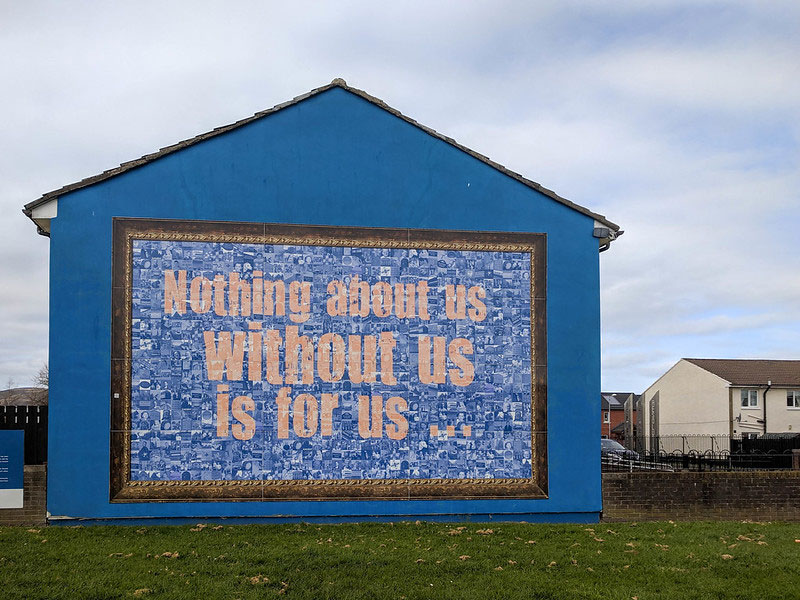The following practices were developed for nonprofit capacity builders by nonprofit capacity builders. Do the authors really want consultants to perpetuate an American class system? Quite the opposite—these 14 practices are object lessons to convince organizational development consultants to do no harm to the communities served by their nonprofit clients. And if they inspire some greater ability to laugh at ourselves along the way, so much the better.
Many thanks to Brigette Rouson, manager for the Cultural Competency Initiative at the Alliance for Nonprofit Management (www.allianceonline.org), and Gita Gulati-Partee at OpenSource Leadership Strategies, Inc. (www.opensourceleadership.com) for their valuable contributions to this list.
What follows are unadvisable uses of power tools:
1. Arrange for client organizations to bring their donors face-to-face with the gritty reality of neighborhood life (use a tour bus with an excellent sound system so that the grim narration really sinks in). Less advisable: Direct conversations with residents—these are risky and frequently go off-message.
2. If the organization’s management and board have already decided what the community needs, don’t complicate the process by involving constituents. They may bring a different perspective to defining the problems to be addressed, the vision to be realized, and strategies chosen. No matter how disconnected the organization’s plans, don’t make yourself obnoxious by bringing this up.
3. In the alternative, undertake elaborate and highly visible processes to seek the perspective of constituents, giving extensive credits and gracious acknowledgement to its importance. Then avoid documenting or acting on the actual content of their recommendations, in deference to the views of organizational leadership and funders. Take care not to point out any differences for the purpose of resolving them; this only creates discomfort and may delay payment of fees.
4. Always praise community residents, but avoid being alone or in close situations, particularly if they are young, poor, people of color, or people who speak their minds with far more concern for honesty than niceties. Extensive contact may have unintended or unknown consequences. (If you already use this approach, do not explore the roots of this fear or seek to alter your belief system.)
5. Remember the market reality that makes most nonprofits’ survival dependent on the approval of customer-buyers (funders or organization management) rather than customer-beneficiaries (constituents). (Only urge a means of changing this dynamic if you are fairly sure this will be your last contract anyway.)
6. Encourage client organizations to accept contracts or conditions set by funders, since these are tied to valuable resources to carry out their missions. Obviously, there are risks—such as large national funders that episodically desert communities mid-stream or rigorously enforce their one-size-fits-all approach. Still, a clear benefit is that during the actual contract period your clients will likely need even more consultation.
Sign up for our free newsletters
Subscribe to NPQ's newsletters to have our top stories delivered directly to your inbox.
By signing up, you agree to our privacy policy and terms of use, and to receive messages from NPQ and our partners.
7. Concentrate your work on making an institution look good in management or funding and fulfilling your agreement with clients—without being distracted by the interests of the beneficiary community. However, if your consulting work is underwritten by a specific funder, and that funder communicates their desires (which may be subtle) or challenges your conclusions, in this situation you must ignore both the community and the institution, and respond to the source of your fee—the funder.
8. Remember that successful boards are made up of people who have not been considered failures in the rest of their lives. Encourage client organizations to adopt the asset governance model—where board members actually know what money is because of their personal wealth—and then be sure that any process caters to that base. For seasoning, include one or two colorful community residents, so that filling out funder diversity charts won’t be too painful and people can see—if not hear or heed—the differences.
9. Organizational realities may dictate huge gaps—between management and front line workers—in opportunities for pay, training resources, recognition, and other means of advancement or satisfaction. In human services organizations, ignore the frequent practice of pegging certain employees as “outreach workers” or administrative support, having little chance to take on new work or reap greater rewards. Actively collude in hiding the gaps and keep to the custom of leaving it out of strategic conversations. Raising internal equity issues complicates any consulting or training engagement. If employees are actually showing up for work, you can assume they are happy to have a job near home.
10. Healthy organizations are open to new information and cutting-edge approaches in their field. Encourage client organizations to allocate increasingly large sums of money for the hiring of other consultants and high-energy experts with graphics-rich presentations (preferably using costly equipment and software), since advances in the field depend on consultant reciprocity.
11. Organizational effectiveness requires oligarchy. Teaching clients how to rigidly enforce hierarchy is simply the only normal advice to provide. Rumblings to the contrary from young and emerging leaders? It is just a phase. Wisdom and leadership flow from the responsibility that comes with top positions, especially if organizations adopt corporate-sounding titles like CEO, CFO, and COO—and operate with a strict chain of command.
12. Because formal education is a reliable proxy for mental acuity, begin by asking about the source of a person’s graduate degree. (If they have none, speak more slowly and nod a lot as if you are noting what they say.) Professionalism equates to level of formal education, which speeds everything from executive searches to sorting strategic plan comments.
13. Take to heart the reality that issues of race and class share precisely the same dynamics. People of color share a bond across class that allows one group to effectively speak for the other, particularly if it’s middle or upper middle class folks representing the views of their poorer counterparts. Stick to something simple, and don’t get confused by notions of diversity that could lead to something radical and unpredictable, like equal shared power.
14. As an adult and a consultant, stick to your convictions. Truthfully, everything you need to know you learned in childhood. Don’t examine your own class identity and don’t probe how this shapes your approach—including your limitations and biases—as a capacity builder. You need to decide whether you are going to be one of those who moan about where the world is headed, or one who helps it get there.













